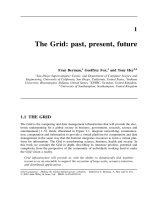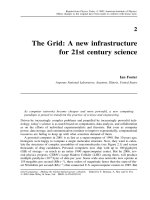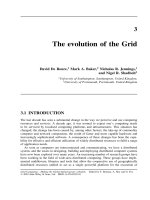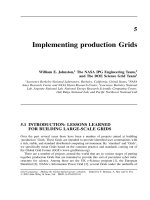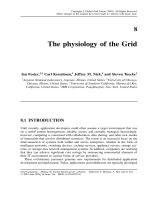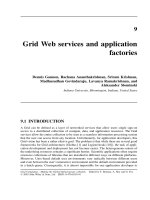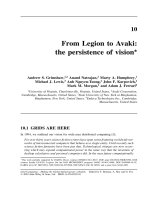Grid Computing P8
Bạn đang xem bản rút gọn của tài liệu. Xem và tải ngay bản đầy đủ của tài liệu tại đây (327.07 KB, 33 trang )
Copyright
Global Grid Forum (2002). All Rights Reserved.
Minor changes to the original have been made to conform with house style.
8
The physiology of the Grid
Ian Foster,
1,2
Carl Kesselman,
3
Jeffrey M. Nick,
4
and Steven Tuecke
1
1
Argonne National Laboratory, Argonne, Illinois, United States,
2
University of Chicago,
Chicago, Illinois, United States,
3
University of Southern California, Marina del Rey,
California, United States,
4
IBM Corporation, Poughkeepsie, New York, United States
8.1 INTRODUCTION
Until recently, application developers could often assume a target environment that was
(to a useful extent) homogeneous, reliable, secure, and centrally managed. Increasingly,
however, computing is concerned with collaboration, data sharing, and other new modes
of interaction that involve distributed resources. The result is an increased focus on the
interconnection of systems both within and across enterprises, whether in the form of
intelligent networks, switching devices, caching services, appliance servers, storage sys-
tems, or storage area network management systems. In addition, companies are realizing
that they can achieve significant cost savings by outsourcing nonessential elements of
their IT environment to various forms of service providers.
These evolutionary pressures generate new requirements for distributed application
development and deployment. Today, applications and middleware are typically developed
Grid Computing – Making the Global Infrastructure a Reality. Edited by F. Berman, A. Hey and G. Fox
2003 John Wiley & Sons, Ltd ISBN: 0-470-85319-0
218
IAN FOSTER ET AL.
for a specific platform (e.g., Windows NT, a flavor of Unix, a mainframe, J2EE, Microsoft
.NET) that provides a hosting environment for running applications. The capabilities
provided by such platforms may range from integrated resource management functions
to database integration, clustering services, security, workload management, and prob-
lem determination – with different implementations, semantic behaviors, and application
programming interfaces (APIs) for these functions on different platforms. But in spite
of this diversity, the continuing decentralization and distribution of software, hardware,
and human resources make it essential that we achieve desired qualities of service
(QoS) – whether measured in terms of common security semantics, distributed work-
flow and resource management performance, coordinated fail-over, problem determination
services, or other metrics – on resources assembled dynamically from enterprise sys-
tems, SP systems, and customer systems. We require new abstractions and concepts that
allow applications to access and share resources and services across distributed, wide-
area networks.
Such problems have been for some time a central concern of the developers of dis-
tributed systems for large-scale scientific research. Work within this community has led
to the development of Grid technologies [1, 2], which address precisely these prob-
lems and which are seeing widespread and successful adoption for scientific and techni-
cal computing.
In an earlier article, we defined Grid technologies and infrastructures as supporting the
sharing and coordinated use of diverse resources in dynamic, distributed ‘virtual organiza-
tions’ (VOs) [2]. We defined essential properties of Grids and introduced key requirements
for protocols and services, distinguishing among connectivity protocols concerned with
communication and authentication, resource protocols concerned with negotiating access
to individual resources, and collective protocols and services concerned with the coor-
dinated use of multiple resources. We also described the Globus Toolkit
TM 1
[3], an
open-source reference implementation of key Grid protocols that supports a wide variety
of major e-Science projects.
Here we extend this argument in three respects to define more precisely how a Grid
functions and how Grid technologies can be implemented and applied. First, while Ref-
erence [2] was structured in terms of the protocols required for interoperability among
VO components, we focus here on the nature of the services that respond to protocol
messages. We view a Grid as an extensible set of Grid services that may be aggregated in
various ways to meet the needs of VOs, which themselves can be defined in part by the
services that they operate and share. We then define the behaviors that such Grid services
should possess in order to support distributed systems integration. By stressing function-
ality (i.e., ‘physiology’), this view of Grids complements the previous protocol-oriented
(‘anatomical’) description.
Second, we explain how Grid technologies can be aligned with Web services technolo-
gies [4, 5] to capitalize on desirable Web services properties, such as service description
and discovery; automatic generation of client and server code from service descriptions;
binding of service descriptions to interoperable network protocols; compatibility with
emerging higher-level open standards, services and tools; and broad commercial support.
1
Globus Project and Globus Toolkit are trademarks of the University of Chicago.
THE PHYSIOLOGY OF THE GRID
219
We call this alignment – and augmentation – of Grid and Web services technologies an
Open Grid Services Architecture (OGSA), with the term architecture denoting here a
well-defined set of basic interfaces from which can be constructed interesting systems
and the term open being used to communicate extensibility, vendor neutrality, and com-
mitment to a community standardization process. This architecture uses the Web Services
Description Language (WSDL) to achieve self-describing, discoverable services and inter-
operable protocols, with extensions to support multiple coordinated interfaces and change
management. OGSA leverages experience gained with the Globus Toolkit to define con-
ventions and WSDL interfaces for a Grid service, a (potentially transient) stateful service
instance supporting reliable and secure invocation (when required), lifetime management,
notification, policy management, credential management, and virtualization. OGSA also
defines interfaces for the discovery of Grid service instances and for the creation of tran-
sient Grid service instances. The result is a standards-based distributed service system (we
avoid the term distributed object system owing to its overloaded meaning) that supports
the creation of the sophisticated distributed services required in modern enterprise and
interorganizational computing environments.
Third, we focus our discussion on commercial applications rather than the scientific
and technical applications emphasized in References [1, 2]. We believe that the same
principles and mechanisms apply in both environments. However, in commercial set-
tings we need, in particular, seamless integration with existing resources and applications
and with tools for workload, resource, security, network QoS, and availability manage-
ment. OGSA’s support for the discovery of service properties facilitates the mapping
or adaptation of higher-level Grid service functions to such native platform facilities.
OGSA’s service orientation also allows us to virtualize resources at multiple levels, so
that the same abstractions and mechanisms can be used both within distributed Grids
supporting collaboration across organizational domains and within hosting environments
spanning multiple tiers within a single IT domain. A common infrastructure means
that differences (e.g., relating to visibility and accessibility) derive from policy con-
trols associated with resource ownership, privacy, and security, rather than interaction
mechanisms. Hence, as today’s enterprise systems are transformed from separate com-
puting resource islands to integrated, multitiered distributed systems, service components
can be integrated dynamically and flexibly, both within and across various organiza-
tional boundaries.
The rest of this article is as follows. In Section 8.2, we examine the issues that motivate
the use of Grid technologies in commercial settings. In Section 8.3, we review the Globus
Toolkit and Web services, and in Section 8.4, we motivate and introduce our Open Grid
Services Architecture. In Sections 8.5 to 8.8, we present an example and discuss protocol
implementations and higher-level services. We discuss related work in Section 8.9 and
summarize our discussion in Section 8.10.
We emphasize that the OGSA and associated Grid service specifications continue to
evolve as a result of both standard work within the Global Grid Forum (GGF) and
implementation work within the Globus Project and elsewhere. Thus the technical content
in this article, and in an earlier abbreviated presentation [6], represents only a snapshot
of a work in progress.
220
IAN FOSTER ET AL.
8.2 THE NEED FOR GRID TECHNOLOGIES
Grid technologies support the sharing and coordinated use of diverse resources in dynamic
VOs – that is, the creation, from geographically and organizationally distributed compo-
nents, of virtual computing systems that are sufficiently integrated to deliver desired
QoS [2].
Grid concepts and technologies were first developed to enable resource sharing within
far-flung scientific collaborations [1, 7–11]. Applications include collaborative visualiza-
tion of large scientific datasets (pooling of expertise), distributed computing for computa-
tionally demanding data analyses (pooling of compute power and storage), and coupling
of scientific instruments with remote computers and archives (increasing functionality as
well as availability) [12]. We expect similar applications to become important in commer-
cial settings, initially for scientific and technical computing applications (where we can
already point to success stories) and then for commercial distributed computing applica-
tions, including enterprise application integration and business-to-business (B2B) partner
collaboration over the Internet. Just as the World Wide Web began as a technology for
scientific collaboration and was adopted for e-Business, we expect a similar trajectory for
Grid technologies.
Nevertheless, we argue that Grid concepts are critically important for commercial
computing, not primarily as a means of enhancing capability but rather as a solution to
new challenges relating to the construction of reliable, scalable, and secure distributed
systems. These challenges derive from the current rush, driven by technology trends
and commercial pressures, to decompose and distribute through the network previously
monolithic host-centric services, as we now discuss.
8.2.1 The evolution of enterprise computing
In the past, computing typically was performed within highly integrated host-centric enter-
prise computing centers. While sophisticated distributed systems (e.g., command and
control systems, reservation systems, the Internet Domain Name System [13]) existed,
these have remained specialized niche entities [14, 15].
The rise of the Internet and the emergence of e-Business have, however, led to a
growing awareness that an enterprise’s IT infrastructure also encompasses external net-
works, resources, and services. Initially, this new source of complexity was treated as a
network-centric phenomenon, and attempts were made to construct ‘intelligent networks’
that intersect with traditional enterprise IT data centers only at ‘edge servers’: for example,
an enterprise’s Web point of presence or the virtual private network server that connects
an enterprise network to SP resources. The assumption was that the impact of e-Business
and the Internet on an enterprise’s core IT infrastructure could thus be managed and
circumscribed.
This attempt has, in general, failed because IT services decomposition is also occur-
ring inside enterprise IT facilities. New applications are being developed to programming
models (such as the Enterprise Java Beans component model [16]) that insulate the appli-
cation from the underlying computing platform and support portable deployment across
multiple platforms. This portability in turn allows platforms to be selected on the basis of
THE PHYSIOLOGY OF THE GRID
221
price/performance and QoS requirements, rather than operating system supported. Thus,
for example, Web serving and caching applications target commodity servers rather than
traditional mainframe computing platforms. The resulting proliferation of Unix and NT
servers necessitates distributed connections to legacy mainframe application and data
assets. Increased load on those assets has caused companies to offload nonessential func-
tions (such as query processing) from backend transaction-processing systems to midtier
servers. Meanwhile, Web access to enterprise resources requires ever-faster request ser-
vicing, further driving the need to distribute and cache content closer to the edge of the
network. The overall result is a decomposition of highly integrated internal IT infrastruc-
ture into a collection of heterogeneous and fragmented systems. Enterprises must then
reintegrate (with QoS) these distributed servers and data resources, addressing issues of
navigation, distributed security, and content distribution inside the enterprise, much as on
external networks.
In parallel with these developments, enterprises are engaging ever more aggressively
in e-Business and are realizing that a highly robust IT infrastructure is required to handle
the associated unpredictability and rapid growth. Enterprises are also now expanding the
scope and scale of their enterprise resource planning projects as they try to provide better
integration with customer relationship management, integrated supply chain, and existing
core systems. These developments are adding to the significant pressures on the enterprise
IT infrastructure.
The aggregate effect is that qualities of service traditionally associated with main-
frame host-centric computing [17] are now essential to the effective conduct of e-Business
across distributed compute resources, inside as well as outside the enterprise. For example,
enterprises must provide consistent response times to customers, despite workloads with
significant deviations between average and peak utilization. Thus, they require flexi-
ble resource allocation in accordance with workload demands and priorities. Enterprises
must also provide a secure and reliable environment for distributed transactions flow-
ing across a collection of dissimilar servers, must deliver continuous availability as
seen by end users, and must support disaster recovery for business workflow across a
distributed network of application and data servers. Yet the current paradigm for deliv-
ering QoS to applications via the vertical integration of platform-specific components
and services just does not work in today’s distributed environment: the decomposi-
tion of monolithic IT infrastructures is not consistent with the delivery of QoS through
vertical integration of services on a given platform. Nor are distributed resource man-
agement capabilities effective, being limited by their proprietary nature, inaccessibility
to platform resources, and inconsistencies between similar resources across a distributed
environment.
The result of these trends is that IT systems integrators take on the burden of rein-
tegrating distributed compute resources with respect to overall QoS. However, with-
out appropriate infrastructure tools, the management of distributed computing work-
flow becomes increasingly labor intensive, complex, and fragile as platform-specific
operations staff watch for ‘fires’ in overall availability and performance and verbally
collaborate on corrective actions across different platforms. This situation is not scal-
able, cost effective, or tenable in the face of changes to the computing environment and
application portfolio.
222
IAN FOSTER ET AL.
8.2.2 Service providers and business-to-business computing
Another key trend is the emergence of service providers (SPs) of various types, such
as Web-hosting SPs, content distribution SPs, applications SPs, and storage SPs. By
exploiting economies of scale, SPs aim to take standard e-Business processes, such as
creation of a Web-portal presence, and provide them to multiple customers with supe-
rior price/performance. Even traditional enterprises with their own IT infrastructures are
offloading such processes because they are viewed as commodity functions.
Such emerging ‘eUtilities’ (a term used to refer to service providers offering contin-
uous, on-demand access) are beginning to offer a model for carrier-grade IT resource
delivery through metered usage and subscription services. Unlike the computing services
companies of the past, which tended to provide off-line batch-oriented processes, resources
provided by eUtilities are often tightly integrated with enterprise computing infrastruc-
tures and used for business processes that span both in-house and outsourced resources.
Thus, a price of exploiting the economies of scale that are enabled by eUtility structures
is a further decomposition and distribution of enterprise computing functions. Providers
of eUtilities face their own technical challenges. To achieve economies of scale, eUtility
providers require server infrastructures that can be easily customized on demand to meet
specific customer needs. Thus, there is a demand for IT infrastructure that (1) supports
dynamic resource allocation in accordance with service-level agreement policies, efficient
sharing and reuse of IT infrastructure at high utilization levels, and distributed secu-
rity from edge of network to application and data servers and (2) delivers consistent
response times and high levels of availability, which in turn drives a need for end-to-end
performance monitoring and real-time reconfiguration.
Still another key IT industry trend is cross-enterprise B2B collaboration such as
multiorganization supply chain management, virtual Web malls, and electronic market
auctions. B2B relationships are, in effect, virtual organizations, as defined above – albeit
with particularly stringent requirements for security, audibility, availability, service-level
agreements, and complex transaction processing flows. Thus, B2B computing represents
another source of demand for distributed systems integration, characterized often by large
differences among the information technologies deployed within different organizations.
8.3 BACKGROUND
We review two technologies on which we build to define the Open Grid Services Architec-
ture: the Globus Toolkit, which has been widely adopted as a Grid technology solution for
scientific and technical computing, and Web services, which have emerged as a popular
standards-based framework for accessing network applications.
8.3.1 The Globus Toolkit
The Globus Toolkit [2, 3] is a community-based, open-architecture, open-source set of
services and software libraries that support Grids and Grid applications. The toolkit
addresses issues of security, information discovery, resource management, data manage-
ment, communication, fault detection, and portability. Globus Toolkit mechanisms are in
use at hundreds of sites and by dozens of major Grid projects worldwide.
THE PHYSIOLOGY OF THE GRID
223
The toolkit components that are most relevant to OGSA are the Grid Resource
Allocation and Management (GRAM) protocol and its ‘gatekeeper’ service, which
provides for secure, reliable service creation and management [18]; the Meta Directory
Service (MDS-2) [19], which provides for information discovery through soft-state
registration [20, 21], data modeling, and a local registry (‘GRAM reporter’ [18]); and
the Grid security infrastructure (GSI), which supports single sign-on, delegation, and
credential mapping. As illustrated in Figure 8.1, these components provide the essential
elements of a service-oriented architecture, but with less generality than is achieved
in OGSA.
The GRAM protocol provides for the reliable, secure remote creation and manage-
ment of arbitrary computations: what we term in this article as transient service instances.
GSI mechanisms are used for authentication, authorization, and credential delegation [22]
to remote computations. A two-phase commit protocol is used for reliable invocation,
based on techniques used in the Condor system [23]. Service creation is handled by a
small, trusted ‘gatekeeper’ process (termed a factory in this article), while a GRAM
reporter monitors and publishes information about the identity and state of local compu-
tations (registry ).
MDS-2 [19] provides a uniform framework for discovering and accessing system con-
figuration and status information such as compute server configuration, network status,
or the locations of replicated datasets (what we term a discovery interface in this chap-
ter). MDS-2 uses a soft-state protocol, the Grid Notification Protocol [24], for lifetime
management of published information.
The public key-based GSI protocol [25] provides single sign-on authentication, com-
munication protection, and some initial support for restricted delegation. In brief, single
sign-on allows a user to authenticate once and thus create a proxy credential that a program
can use to authenticate with any remote service on the user’s behalf. Delegation allows for
the creation and communication to a remote service of delegated proxy credentials that the
remote service can use to act on the user’s behalf, perhaps with various restrictions; this
Gatekeeper
(factory)
Reporter
(registry +
discovery)
Grid
information
index server
(discovery)
User
User
process #1
Proxy
User
process #2
Proxy #2
Other service
(e.g.
GridFTP)
Authenticate &
create proxy
credential
Request
process
creation
Create
process
Contact
other
service
Register with discovery service
Register
Figure 8.1 Selected Globus Toolkit mechanisms, showing initial creation of a proxy credential
and subsequent authenticated requests to a remote gatekeeper service, resulting in the creation of
user process #2, with associated (potentially restricted) proxy credential, followed by a request to
another remote service. Also shown is soft-state service registration via MDS-2.
224
IAN FOSTER ET AL.
capability is important for nested operations. (Similar mechanisms can be implemented
within the context of other security technologies, such as Kerberos [26], although with
potentially different characteristics.)
GSI uses X.509 certificates, a widely employed standard for Public Key Infrastructure
(PKI) certificates, as the basis for user authentication. GSI defines an X.509 proxy cer-
tificate [27] to leverage X.509 for support of single sign-on and delegation. (This proxy
certificate is similar in concept to a Kerberos forwardable ticket but is based purely on pub-
lic key cryptographic techniques.) GSI typically uses the Transport Layer Security (TLS)
protocol (the follow-on to Secure Sockets Layer (SSL)) for authentication, although other
public key-based authentication protocols could be used with X.509 proxy certificates.
A remote delegation protocol of X.509 proxy certificates is layered on top of TLS. An
Internet Engineering Task Force draft defines the X.509 Proxy Certificate extensions [27].
GGF drafts define the delegation protocol for remote creation of an X.509 proxy certifi-
cate [27] and Generic Security Service API (GSS-API) extensions that allow this API to
be used effectively for Grid programming.
Rich support for restricted delegation has been demonstrated in prototypes and is a
critical part of the proposed X.509 Proxy Certificate Profile [27]. Restricted delegation
allows one entity to delegate just a subset of its total privileges to another entity. Such
restriction is important to reduce the adverse effects of either intentional or accidental
misuse of the delegated credential.
8.3.2 Web services
The term Web services describes an important emerging distributed computing paradigm
that differs from other approaches such as DCE, CORBA, and Java RMI in its focus
on simple, Internet-based standards (e.g., eXtensible Markup Language: XML [28, 29])
to address heterogeneous distributed computing. Web services define a technique for
describing software components to be accessed, methods for accessing these components,
and discovery methods that enable the identification of relevant SPs. Web services are
programming language–, programming model–, and system software–neutral.
Web services standards are being defined within the W3C and other standards bodies
and form the basis for major new industry initiatives such as Microsoft (.NET), IBM
(Dynamic e-Business), and Sun (Sun ONE). We are particularly concerned with three of
these standards: SOAP, WSDL, and WS-Inspection.
•
The Simple Object Access Protocol (SOAP) [30] provides a means of messaging between
a service provider and a service requestor. SOAP is a simple enveloping mechanism for
XML payloads that defines a remote procedure call (RPC) convention and a messaging
convention. SOAP is independent of the underlying transport protocol; SOAP payloads
can be carried on HTTP, FTP, Java Messaging Service (JMS), and the like. We emphasize
that Web services can describe multiple access mechanisms to the underlying software
component. SOAP is just one means of formatting a Web service invocation.
•
The Web Services Description Language (WSDL) [31] is an XML document for describing
Web services as a set of endpoints operating on messages containing either document-
oriented (messaging) or RPC payloads. Service interfaces are defined abstractly in terms
THE PHYSIOLOGY OF THE GRID
225
of message structures and sequences of simple message exchanges (or operations, in
WSDL terminology) and then bound to a concrete network protocol and data-encoding
format to define an endpoint. Related concrete endpoints are bundled to define abstract
endpoints (services). WSDL is extensible to allow description of endpoints and the con-
crete representation of their messages for a variety of different message formats and
network protocols. Several standardized binding conventions are defined describing how
to use WSDL in conjunction with SOAP 1.1, HTTP GET/POST, and (MIME) Multimedia
Internet Message Extensions.
•
WS-Inspection [32] comprises a simple XML language and related conventions for
locating service descriptions published by an SP. A WS-Inspection language (WSIL)
document can contain a collection of service descriptions and links to other sources
of service descriptions. A service description is usually a URL to a WSDL document;
occasionally, a service description can be a reference to an entry within a Universal
Description, Discovery, and Integration (UDDI) [33] registry. A link is usually a URL
to another WS-Inspection document; occasionally, a link is a reference to a UDDI entry.
With WS-Inspection, an SP creates a WSIL document and makes the document network
accessible. Service requestors use standard Web-based access mechanisms (e.g., HTTP
GET) to retrieve this document and discover what services the SP advertises. WSIL
documents can also be organized in different forms of index.
Various other Web services standards have been or are being defined. For example, Web
Services Flow Language (WSFL) [34] addresses Web services orchestration,thatis,the
building of sophisticated Web services by composing simpler Web services.
The Web services framework has two advantages for our purposes. First, our need to
support the dynamic discovery and composition of services in heterogeneous environ-
ments necessitates mechanisms for registering and discovering interface definitions and
endpoint implementation descriptions and for dynamically generating proxies based on
(potentially multiple) bindings for specific interfaces. WSDL supports this requirement by
providing a standard mechanism for defining interface definitions separately from their
embodiment within a particular binding (transport protocol and data-encoding format).
Second, the widespread adoption of Web services mechanisms means that a framework
based on Web services can exploit numerous tools and extant services, such as WSDL
processors that can generate language binding for a variety of languages (e.g., Web Ser-
vices Invocation Framework: WSIF [35]), workflow systems that sit on top of WSDL,
and hosting environments for Web services (e.g., Microsoft .NET and Apache Axis). We
emphasize that the use of Web services does not imply the use of SOAP for all commu-
nications. If needed, alternative transports can be used, for example, to achieve higher
performance or to run over specialized network protocols.
8.4 AN OPEN GRID SERVICES ARCHITECTURE
We have argued that within internal enterprise IT infrastructures, SP-enhanced IT infras-
tructures, and multiorganizational Grids, computing is increasingly concerned with the
creation, management, and application of dynamic ensembles of resources and services
(and people) – what we call virtual organizations [2]. Depending on the context, these
226
IAN FOSTER ET AL.
ensembles can be small or large, short-lived or long-lived, single institutional or multi-
institutional, and homogeneous or heterogeneous. Individual ensembles may be structured
hierarchically from smaller systems and may overlap in membership.
We assert that regardless of these differences, developers of applications for VOs
face common requirements as they seek to deliver QoS – whether measured in terms
of common security semantics, distributed workflow and resource management, coordi-
nated fail-over, problem determination services, or other metrics – across a collection of
resources with heterogeneous and often dynamic characteristics.
We now turn to the nature of these requirements and the mechanisms required to address
them in practical settings. Extending our analysis in Reference [2], we introduce an Open
Grid Services Architecture that supports the creation, maintenance, and application of
ensembles of services maintained by VOs.
We start our discussion with some general remarks concerning the utility of a service-
oriented Grid architecture, the importance of being able to virtualize Grid services, and
essential service characteristics. Then, we introduce the specific aspects that we standard-
ize in our definition of what we call a Grid service. We present more technical details in
Section 8.6 (and in Reference [36]).
8.4.1 Service orientation and virtualization
When describing VOs, we can focus on the physical resources being shared (as in Refer-
ence [2]) or on the services supported by these resources. (A service is a network-enabled
entity that provides some capability. The term object could arguably also be used, but
we avoid that term owing to its overloaded meaning.) In OGSA, we focus on services:
computational resources, storage resources, networks, programs, databases, and the like
are all represented as services.
Regardless of our perspective, a critical requirement in a distributed, multiorganiza-
tional Grid environment is for mechanisms that enable interoperability [2]. In a service-
oriented view, we can partition the interoperability problem into two subproblems, namely,
the definition of service interfaces and the identification of the protocol(s) that can be
used to invoke a particular interface – and, ideally, agreement on a standard set of
such protocols.
A service-oriented view allows us to address the need for standard interface definition
mechanisms, local/remote transparency, adaptation to local OS services, and uniform ser-
vice semantics. A service-oriented view also simplifies virtualization – that is, the encap-
sulation behind a common interface of diverse implementations. Virtualization allows for
consistent resource access across multiple heterogeneous platforms with local or remote
location transparency, and enables mapping of multiple logical resource instances onto
the same physical resource and management of resources within a VO based on composi-
tion from lower-level resources. Virtualization allows the composition of services to form
more sophisticated services – without regard for how the services being composed are
implemented. Virtualization of Grid services also underpins the ability to map common
service semantic behavior seamlessly onto native platform facilities.
Virtualization is easier if service functions can be expressed in a standard form, so
that any implementation of a service is invoked in the same manner. WSDL, which we
THE PHYSIOLOGY OF THE GRID
227
adopt for this purpose, supports a service interface definition that is distinct from the
protocol bindings used for service invocation. WSDL allows for multiple bindings for a
single interface, including distributed communication protocol(s) (e.g., HTTP) as well as
locally optimized binding(s) (e.g., local Inter-Process Communication (IPC)) for interac-
tions between request and service processes on the same host. Other binding properties
may include reliability (and other forms of QoS) as well as authentication and delegation
of credentials. The choice of binding should always be transparent to the requestor with
respect to service invocation semantics – but not with respect to other things: for example,
a requestor should be able to choose a particular binding for performance reasons.
The service interface definition and access binding are also distinct from the imple-
mentation of the functionality of the service. A service can support multiple implemen-
tations on different platforms, facilitating seamless overlay not only to native platform
facilities but also, via the nesting of service implementations, to virtual ensembles of
resources. Depending on the platform and context, we might use the following imple-
mentation approaches.
1. We can use a reference implementation constructed for full portability across multiple
platforms to support the execution environment (container) for hosting a service.
2. On a platform possessing specialized native facilities for delivering service functional-
ity, we might map from the service interface definition to the native platform facilities.
3. We can also apply these mechanisms recursively so that a higher-level service is
constructed by the composition of multiple lower-level services, which themselves
may either map to native facilities or decompose further. The service implementation
then dispatches operations to lower-level services (see also Section 8.4.4).
As an example, consider a distributed trace facility that records trace records to a reposi-
tory. On a platform that does not support a robust trace facility, a reference implementation
can be created and hosted in a service execution environment for storing and retrieving
trace records on demand. On a platform already possessing a robust trace facility, how-
ever, we can integrate the distributed trace service capability with the native platform
trace mechanism, thus leveraging existing operational trace management tools, auxil-
iary off-load, dump/restore, and the like, while semantically preserving the logical trace
stream through the distributed trace service. Finally, in the case of a higher-level service,
trace records obtained from lower-level services would be combined and presented as the
integrated trace facility for the service.
Central to this virtualization of resource behaviors is the ability to adapt to operat-
ing system functions on specific hosts. A significant challenge when developing these
mappings is to enable exploitation of native capabilities – whether concerned with per-
formance monitoring, workload management, problem determination, or enforcement of
native platform security policy – so that the Grid environment does not become the least
common denominator of its constituent pieces. Grid service discovery mechanisms are
important in this regard, allowing higher-level services to discover what capabilities are
supported by a particular implementation of an interface. For example, if a native platform
supports reservation capabilities, an implementation of a resource management interface
(e.g., GRAM [18, 37]) can exploit those capabilities.
228
IAN FOSTER ET AL.
Thus, our service architecture supports local and remote transparency with respect
to service location and invocation. It also provides for multiple protocol bindings to
facilitate localized optimization of services invocation when the service is hosted locally
with the service requestor, as well as to enable protocol negotiation for network flows
across organizational boundaries where we may wish to choose between several InterGrid
protocols, each optimized for a different purpose. Finally, we note that an implementation
of a particular Grid service interface may map to native, nondistributed platform functions
and capabilities.
8.4.2 Service semantics: The Grid service
Our ability to virtualize and compose services depends on more than standard inter-
face definitions. We also require standard semantics for service interactions so that, for
example, different services follow the same conventions for error notification. To this end,
OGSA defines what we call a Grid service: a Web service that provides a set of well-
defined interfaces and that follows specific conventions. The interfaces address discovery,
dynamic service creation, lifetime management, notification, and manageability; the con-
ventions address naming and upgradability. We expect also to address authorization and
concurrency control as OGSA evolves. Two other important issues, authentication and
reliable invocation, are viewed as service protocol bindings and are thus external to the
core Grid service definition but must be addressed within a complete OGSA implemen-
tation. This separation of concerns increases the generality of the architecture without
compromising functionality.
The interfaces and conventions that define a Grid service are concerned, in particular,
with behaviors related to the management of transient service instances. VO participants
typically maintain not merely a static set of persistent services that handle complex activ-
ity requests from clients. They often need to instantiate new transient service instances
dynamically, which then handle the management and interactions associated with the
state of particular requested activities. When the activity’s state is no longer needed, the
service can be destroyed. For example, in a videoconferencing system, the establishment
of a videoconferencing session might involve the creation of service instances at inter-
mediate points to manage end-to-end data flows according to QoS constraints. Or, in a
Web serving environment, service instances might be instantiated dynamically to provide
for consistent user response time by managing application workload through dynamically
added capacity. Other examples of transient service instances might be a query against a
database, a data-mining operation, a network bandwidth allocation, a running data trans-
fer, and an advance reservation for processing capability. (These examples emphasize that
service instances can be extremely lightweight entities, created to manage even short-lived
activities.) Transience has significant implications of how services are managed, named,
discovered, and used.
8.4.2.1 Upgradeability conventions and transport protocols
Services within a complex distributed system must be independently upgradable. Hence,
versioning and compatibility between services must be managed and expressed so that
THE PHYSIOLOGY OF THE GRID
229
clients can discover not only specific service versions but also compatible services. Fur-
ther, services (and the hosting environments in which they run) must be upgradable
without disrupting the operation of their clients. For example, an upgrade to the hosting
environment may change the set of network protocols that can be used to communicate
with the service, and an upgrade to the service itself may correct errors or even enhance
the interface. Hence, OGSA defines conventions that allow us to identify when a service
changes and when those changes are backwardly compatible with respect to interface
and semantics (but not necessarily network protocol). OGSA also defines mechanisms for
refreshing a client’s knowledge of a service, such as what operations it supports or what
network protocols can be used to communicate with the service. A service’s description
indicates the protocol binding(s) that can be used to communicate with the service. Two
properties will often be desirable in such bindings.
•
Reliable service invocation: Services interact with one another by the exchange of
messages. In distributed systems prone to component failure, however, one can never
guarantee that a message has been delivered. The existence of internal state makes it
important to be able to guarantee that a service has received a message either once or not
at all. From this foundation one can build a broad range of higher-level per-operation
semantics, such as transactions.
•
Authentication: Authentication mechanisms allow the identity of individuals and ser-
vices to be established for policy enforcement. Thus, one will often desire a transport
protocol that provides for mutual authentication of client and service instance, as well
as the delegation of proxy credentials. From this foundation one can build a broad
range of higher-level authorization mechanisms.
8.4.2.2 Standard interfaces
The interfaces (in WSDL terms, portTypes) that define a Grid service are listed in Table 8.1,
introduced here, and described in more detail in Section 8.6 (and in Reference [36]). Note
that while OGSA defines a variety of behaviors and associated interfaces, all but one of
these interfaces (GridService) are optional.
Discovery: Applications require mechanisms for discovering available services and for
determining the characteristics of those services so that they can configure themselves and
their requests to those services appropriately. We address this requirement by defining
•
a standard representation for service data, that is, information about Grid service
instances, which we structure as a set of named and typed XML elements called service
data elements, encapsulated in a standard container format;
•
a standard operation, FindServiceData (within the required GridService interface), for
retrieving service data from individual Grid service instances (‘pull’ mode access; see
the NotificationSource interface below for ‘push’ mode access); and
•
standard interfaces for registering information about Grid service instances with registry
services (Registry ) and for mapping from ‘handles’ to ‘references’ (HandleMap –to
be explained in Section 8.6, when we discuss naming).
